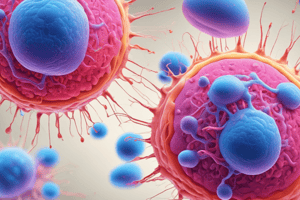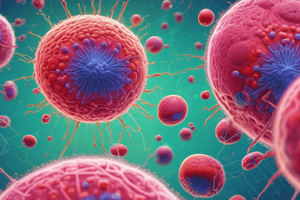Podcast
Questions and Answers
Which type of immune cell is NOT classified under the innate immune system?
Which type of immune cell is NOT classified under the innate immune system?
- NK cells
- B cells (correct)
- Macrophages
- Neutrophils
What is primarily recognized by Pattern Recognition Receptors (PRRs) in innate immune cells?
What is primarily recognized by Pattern Recognition Receptors (PRRs) in innate immune cells?
- Pathogen-associated molecular patterns (correct)
- Cytokines
- Antigens
- Adaptive immune responses
What is the role of the Complement system in the innate immune response?
What is the role of the Complement system in the innate immune response?
- To promote phagocytosis and inflammation (correct)
- To produce antibodies
- To activate T cells
- To neutralize toxins
Which of the following are part of the chemical barriers in the innate immune system?
Which of the following are part of the chemical barriers in the innate immune system?
Which of these immune cells is specifically known for targeting intracellular pathogens?
Which of these immune cells is specifically known for targeting intracellular pathogens?
Which immune cell component is involved in both innate and adaptive immunity?
Which immune cell component is involved in both innate and adaptive immunity?
What is NOT a function of macrophages in the innate immune response?
What is NOT a function of macrophages in the innate immune response?
What differentiates the alternative pathway from other pathways of complement activation?
What differentiates the alternative pathway from other pathways of complement activation?
Which protein is responsible for ligating the processed broken ends of DNA?
Which protein is responsible for ligating the processed broken ends of DNA?
What are the three properties affected by MHC polymorphism?
What are the three properties affected by MHC polymorphism?
What is the role of dendritic cells in lymph nodes?
What is the role of dendritic cells in lymph nodes?
What signifies the concept of codominance in MHC diversity?
What signifies the concept of codominance in MHC diversity?
What initiates T cell activation?
What initiates T cell activation?
Which component is crucial for TCR signaling?
Which component is crucial for TCR signaling?
What is the primary function of antigen processing and presentation?
What is the primary function of antigen processing and presentation?
What is the consequence if TCR does not properly bind to peptide-MHC complexes?
What is the consequence if TCR does not properly bind to peptide-MHC complexes?
What do the letters V, D, and J represent in the context of receptor gene segments?
What do the letters V, D, and J represent in the context of receptor gene segments?
Which enzyme is specifically responsible for creating double-stranded breaks during V(D)J recombination?
Which enzyme is specifically responsible for creating double-stranded breaks during V(D)J recombination?
What role does Artemis play in the process of V(D)J recombination?
What role does Artemis play in the process of V(D)J recombination?
Which of the following proteins bind to the DNA breaks during the joining process of V(D)J recombination?
Which of the following proteins bind to the DNA breaks during the joining process of V(D)J recombination?
What happens during the hairpin opening step of V(D)J recombination?
What happens during the hairpin opening step of V(D)J recombination?
What type of DNA repair process is utilized to join broken ends during V(D)J recombination?
What type of DNA repair process is utilized to join broken ends during V(D)J recombination?
Which of the following statements about RAG proteins is true?
Which of the following statements about RAG proteins is true?
Which sequence is crucial for guiding the rearrangement of V, D, and J gene segments?
Which sequence is crucial for guiding the rearrangement of V, D, and J gene segments?
Flashcards are hidden until you start studying
Study Notes
Innate Immune System Recap
- Physical barriers include epithelial and mucosal linings, mucus, and tears.
- Chemical barriers include acidic pH, enzymes, and antimicrobial peptides (AMPs).
- Microbiological barriers include the microbiota.
- Innate immune cells include macrophages, neutrophils, and natural killer (NK) cells.
- Adaptive immunity is mediated by B cells and T cells.
Pathogen Pattern Recognition and Innate Immune Cell Function
- Pattern recognition receptors (PRRs) recognize pathogen-associated molecular patterns (PAMPs) present on pathogens.
- Toll-like receptors (TLRs) recognize PAMPs on the cell surface.
- Nod-like receptors (NLRs) recognize intracellular PAMPs.
- RIG-I-like receptors (RLRs) recognize viral RNA in the cytoplasm.
- PRR signaling triggers the production of cytokines and chemokines, which activate other immune cells and initiate inflammation.
Innate Immune Cell Function
- Macrophages engulf and destroy pathogens through phagocytosis.
- Neutrophils are short-lived phagocytic cells that release antimicrobial substances.
- NK cells destroy infected cells and tumor cells.
Complement Activation and Innate Immune Cell Action
- The complement system is a group of proteins that can directly kill pathogens or enhance other immune responses.
- The alternative pathway of complement activation is triggered by the presence of pathogens on surfaces.
- Complement proteins form the membrane attack complex (MAC), which disrupts the integrity of pathogen membranes.
- Complement also enhances phagocytosis by opsonization.
The Acute-Phase Response and Complement Activation
- The acute-phase response is an early innate immune response to infection or injury.
- It involves the production of acute-phase proteins by the liver, such as C-reactive protein (CRP).
- CRP activates the classical pathway of complement activation.
The Adaptive Immune System
- The adaptive immune system is characterized by its specificity and memory.
- T cells recognize antigen presented by MHC molecules on antigen-presenting cells (APCs).
- B cells produce antibodies that recognize and neutralize pathogens.
Lymphocyte Development and Receptor Gene Recombination
- Lymphocyte development occurs in primary lymphoid tissues, such as the bone marrow and thymus.
- Recombination of receptor genes creates a vast diversity of antigen receptors.
- V(D)J recombination is a process that generates diversity in the antigen-binding sites of T cell receptors (TCRs) and B cell receptors (BCRs).
Antigen Recognition and Presentation
- MHC molecules present peptides derived from pathogens on the cell surface.
- TCRs recognize specific peptide-MHC complexes.
- BCRs bind to intact antigens.
T Cell Activation
- TCR signaling triggers the activation of T cells.
- Co-stimulatory signals, provided by molecules such as CD28, are required for full T cell activation.
- Activated T cells proliferate and differentiate into effector T cells.
B Cell Activation
- B cell activation involves antigen binding to the BCR and co-stimulatory signals.
- Activated B cells differentiate into antibody-secreting plasma cells.
- Antibody-mediated immunity is a major component of the adaptive immune response.
MHC Diversity
- MHC molecules are highly polymorphic, which contributes to the immune system’s ability to recognize a wide array of antigens.
- MHC polymorphism can influence the range of peptides bound, the conformation of the bound peptide, and the interaction of the MHC molecule with the TCR.
Studying That Suits You
Use AI to generate personalized quizzes and flashcards to suit your learning preferences.




